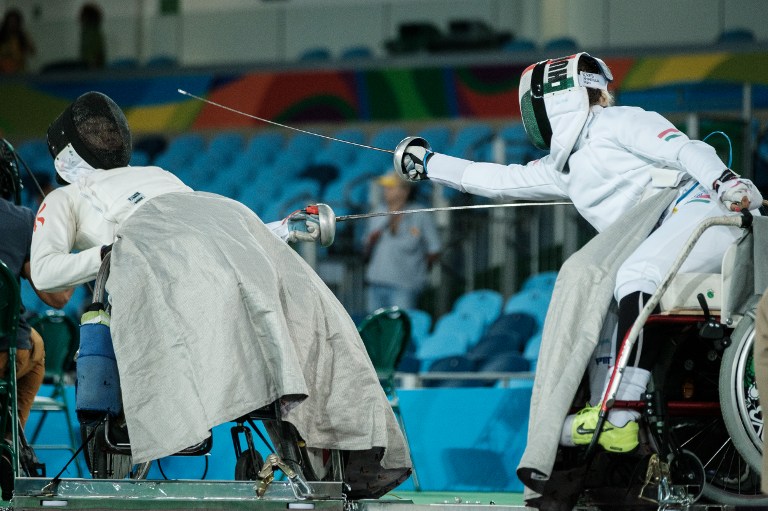
Hong Kong’s Chui Yee Yu (L) competes with Hungary’s Amarilla Veres during the women’s epee team semifinal in the Rio 2016 Paralympic Games at the Olympic Park in Rio de Janeiro on September 15, 2016. / AFP PHOTO / YASUYOSHI CHIBA
The Paralympic wheelchair fencers enter the arena to the strains of the James Bond theme tune, but even 007 probably couldn’t duel while stuck in a chair.
Many skillful athletes are overcoming a lot of disabilities at the Rio Games. However, fencers have a unique edge.
“It’s one of the only combat sports you can do in a wheelchair,” 43-year-old Pierre Mainville, who reached the quarter-finals with the sabre, said on Thursday.
The Canadian took up wheelchair fencing 15 years ago after a policeman bent on killing an ex-girlfriend fired repeatedly into the car carrying her and three others, including Mainville. He was hit six times and left a paraplegic.
If a modern weapon almost took his life, the ancient sword helped him win it back.
“When you put on that mask, you become a warrior,” he said.
Combatants must remain seated in wheelchairs attached to the floor, largely immobilizing their lower bodies, whether the athletes’ legs are paralyzed or not.
Free from the waist up, the fencers engage in furious duels, lunging, parrying and leaning back to escape. The clink and scraping of steel blade against blade fills the air, interrupted by occasional cries of victory or disappointment.
“It’s like chess,” Mainville says. “Only very fast.”
First blood
The fighters resemble something between aliens, ninjas and Medieval knights.
They wear dark masked helmets and white suits wired to register an opponent’s hit. Blankets closing off the area from the waist to the feet are worn like flowing skirts.
The white clothing dates from the days of aristocrats in duels, Mainville says. “They made rules where the first one to bleed loses. Then people tried to cheat by wearing dark clothes, so they said from now on everyone must wear white.”
Like Mainville, Brazilian swordsman Fabio Luiz Damasceno, 33, was paralyzed from the waist down in a shooting. He described the incident as occurring “in a street fight.”
And he’s not the only other shooting victim turned fencer in Rio.
Damasceno’s teammate Jovane Guissone was shot during a robbery in 2004 and lost control of his legs. He took up wheelchair fencing four years later and won gold in the 2012 London Paralympics.
Damasceno says he discovered wheelchair fencing — a sport that has been in the Paralympics since 1960 but only recently arrived in Brazil — by “pure chance.”
And it wasn’t easy to learn the skills needed to wield his weapons of choice, the epee and foil.
“You’re working at very close range, so you have to attack quickly and get out of the way quickly,” he says. “There’s a lot of training. You have to repeat things 10,000 times to do them well.”
Damasceno points out an important complication that onlookers might not even notice. Although all the competitors are all strapped into their chairs and divided into one of three groups of disability, the variations in physical condition, and therefore mobility, can still be huge.
Damasceno has legs but they won’t respond, while a double-amputee opponent may retain use of his thighs, giving him an extra bit of agility and strength in his upper body.
Ultimately, the contest is just an old fashioned sword fight.
“With fencing, your goal is to touch the opponent — and touch first,” Damasceno says.
Or as Greece’s Panagiotis Triantafyllou, 30 — who ended up winning silver in the sabre on Thursday — said: “It helps to have long arms and be smart.”